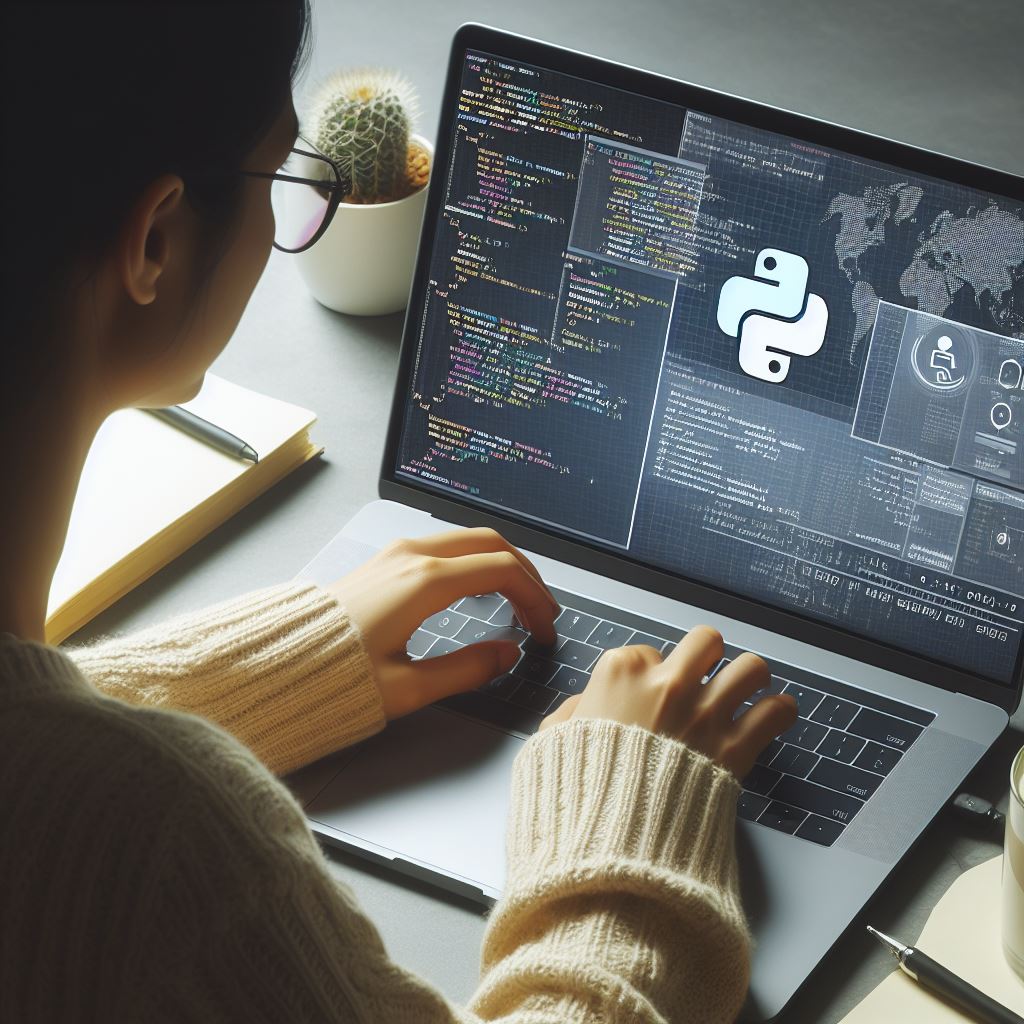Introduction
A. Concept of Coding Blocks in Python
Coding blocks in Python are fundamental units that group statements. They define the structure of your code.
B. Importance of Understanding Coding Blocks
Mastering coding blocks enhances code readability and fosters efficient debugging. It’s the cornerstone of writing organized and scalable programs.
C. Purpose of the Blog Post
- Step-by-Step Learning: This post is your guide to comprehending coding blocks methodically.
- Enhanced Programming Skills: Understand how coding blocks contribute to effective and elegant Python programming.
- Practical Application: Learn through examples and exercises, applying coding blocks for robust and clean code.
Embark on this journey to unravel the essence of coding blocks in Python, paving the way for elevated programming prowess.
What are Coding Blocks?
A. Defining coding blocks
In coding, coding blocks refer to segments of code that are grouped together to perform a specific task.
These blocks of code can be created using indentation in Python.
Coding blocks are essential in organizing and structuring code, making it easier to read and understand.
They contribute to the overall readability and maintainability of the code.
By grouping related lines of code together into blocks, it becomes easier to identify the purpose and functionality of each block.
This helps programmers to quickly navigate and make changes to specific sections of code, improving efficiency and productivity.
Moreover, coding blocks aid in controlling the flow of execution within a program.
They allow for the conditional execution of specific blocks of code based on certain conditions, making the program more flexible and dynamic.
B. Coding blocks can be created using indentation in Python
In Python, coding blocks are created using indentation.
Indentation is not just a matter of style, but it is a fundamental aspect of the language syntax.
The level of indentation determines which lines of code belong to a certain block.
Coding blocks can be created using various control structures provided by Python, such as if statements, for loops, while loops, and function definitions.
Tech Consulting Tailored to Your Coding Journey
Get expert guidance in coding with a personalized consultation. Receive unique, actionable insights delivered in 1-3 business days.
Get StartedFor example, in an if statement, the code block following the condition will only be executed if the condition is true:
if condition:
# Code block to be executed if the condition is trueSimilarly, in a for loop, the indented block of code will be executed repeatedly for each element in the iterable:
for element in iterable:
# Code block to be executed for each elementIn addition, functions in Python also make use of coding blocks.
The code block inside a function definition is only executed when the function is called:
def function_name(parameters):
# Code block to be executed when the function is calledUsing coding blocks in Python provides several benefits.
They improve code organization, make it easier to understand and modify, and allow for conditional execution of specific sections of code.
Coding blocks are segments of code that are grouped together to perform a specific task.
In Python, coding blocks are created using indentation and are essential in organizing and structuring code.
They contribute to code readability, maintainability, and control the flow of execution within a program.
By utilizing coding blocks effectively, programmers can write cleaner and more efficient code.
Read: Python Coding Practice: 5 Projects to Start With
Types of Coding Blocks in Python
When it comes to Python programming, understanding coding blocks is essential.
These blocks are sections of code that serve specific purposes.
By properly utilizing coding blocks, you can build more efficient and organized Python programs.
Build Your Vision, Perfectly Tailored
Get a custom-built website or application that matches your vision and needs. Stand out from the crowd with a solution designed just for you—professional, scalable, and seamless.
Get StartedIn this section, we will discuss the main types of coding blocks in Python, including functions, loops, and conditionals.
A. Functions: Reusable Blocks of Code
One of the fundamental coding blocks in Python is the function.
A function is a named block of code that performs a specific task.
It allows you to organize your code into reusable chunks, making your program easier to read and maintain.
In Python, functions are defined using the “def” keyword followed by the function name and parentheses.
Inside the parentheses, you can specify any parameters that the function requires.
By encapsulating a set of instructions within a function, you can call that function whenever you need to perform the defined task.
B. Loops: Repetitive Execution of Code
Another important type of coding block in Python is the loop.
Loops allow you to repeat a sequence of code multiple times until a specific condition is met.
This capability is especially useful when you want to perform the same set of instructions for a large number of iterations.
In Python, there are two main types of loops: “for” loops and “while” loops.
With a “for” loop, you can iterate over a collection of items, such as a list or a range of numbers.
The loop will execute the specified block of code for each item in the collection.
On the other hand, a “while” loop continues executing a block of code as long as a certain condition remains true.
Optimize Your Profile, Get Noticed
Make your resume and LinkedIn stand out to employers with a profile that highlights your technical skills and project experience. Elevate your career with a polished and professional presence.
Get NoticedThis type of loop is useful when you don’t know the exact number of iterations needed, or when you want to create an infinite loop until a condition is met.
C. Conditionals: Selective Execution of Code
Conditionals are coding blocks that enable selective execution of a block of code based on certain conditions.
It allows your program to make decisions, choosing different paths based on whether certain conditions are true or false.
In Python, conditionals are typically implemented using the “if-else” statement or the “if-elif-else” statement.
With the “if-else” statement, a block of code is executed if a given condition is true, and a different block of code is executed if the condition is false.
The “if-elif-else” statement expands on the “if-else” statement by allowing multiple conditions to be evaluated.
The code block associated with the first true condition will be executed, and if none of the conditions are true, the code block within the “else” clause will be executed.
Coding blocks in Python, such as functions, loops, and conditionals, play a crucial role in structuring and organizing your code.
Functions allow for reusable chunks of code, loops enable repetitive execution, and conditionals provide selective execution based on conditions.
By understanding and utilizing these coding blocks effectively, you can write cleaner, more efficient Python programs.
Read: R vs Python: Which is Better for Data Science?

Creating Coding Blocks in Python
A. The importance of indentation in Python for creating coding blocks
One of the most important aspects of Python programming is indentation.
Indentation plays a crucial role in creating coding blocks in Python.
It helps in defining the structure and hierarchy of code blocks.
Indentation is used to group statements together, indicating that they belong to a particular code block.
This is different from other programming languages where curly braces or keywords are used to define code blocks.
In Python, indentation is the only way to create coding blocks.
B. Examples of how to use indentation to create coding blocks
Let’s take a look at some examples of how indentation is used to create coding blocks in Python.
Example 1:
if condition:
statement1
statement2
statement3In this example, the statements statement1, statement2, and statement3 are indented under the if condition.
This indicates that these statements are part of the code block that executes when the condition is true.
Example 2:
for item in iterable:
statement1
statement2
statement3In this example, the for loop indents statement1, statement2, and statement3.
This signifies the execution of these statements for each item in the iterable object.
C. Common conventions for indentation in Python
Indentation conventions in Python are commonly followed to ensure consistency and readability of code.
Here are some common conventions for indentation in Python:
- Use spaces for indentation, typically 4 spaces per indentation level. Avoid using tabs as it can lead to inconsistent indentation.
- Be consistent with the number of spaces used for indentation throughout the codebase. Mixing tabs and spaces for indentation can cause syntax errors.
- Indent each code block one level deeper than the previous block. This helps in visually representing the hierarchy of code blocks.
- Avoid unnecessary indentation. Only indent the statements that are part of a particular code block.
- Use an editor or IDE that supports automatic indentation. This can help in maintaining consistent indentation without manual effort.
Following these conventions not only makes your code more readable but also helps in identifying code blocks easily.
It is important to note that incorrect indentation can lead to syntax errors or change the meaning of your code.
In summary, indentation is of utmost importance in Python for creating coding blocks.
It helps in organizing and structuring code, making it easier to understand and maintain.
By following the common conventions for indentation, you can ensure consistency and readability in your Python code.
Read: Java vs Python: Which Language Should You Learn First?
Best Practices for Using Coding Blocks in Python
The use of coding blocks in Python is essential for organizing code effectively, improving readability, and maintaining codebases.
By following certain best practices, developers can ensure that their code is easy to understand, debug, and collaborate on.
A. The Significance of Proper Code Organization
Proper code organization plays a crucial role in enhancing readability and maintainability.
It involves breaking down complex code into smaller logical blocks.
Each coding block should have a specific purpose, making it easier to comprehend the code’s functionality.
By using coding blocks, developers can separate different sections of code, such as imports, function definitions, and main logic, thus creating a cleaner structure.
This not only improves readability but also allows for easy navigation within the codebase.
B. Using Descriptive Names for Coding Blocks
Using descriptive names for coding blocks is important to enhance clarity and comprehension.
By choosing meaningful names, developers can immediately understand the purpose and functionality of each block.
When creating coding blocks, it is advisable to use nouns or verb-noun combinations that accurately describe their purpose.
For example, instead of using generic names like “code block 1” or “function 2,” opt for names like “validate_inputs” or “calculate_total_cost.”
This makes it easier to locate and understand specific blocks within the code.
C. The Need for Consistent Indentation
Consistent indentation is crucial in Python as it determines the scope and hierarchy of coding blocks.
It is essential to follow a consistent indentation style throughout the codebase to avoid syntax errors.
Developers should choose a preferred indentation style (spaces or tabs) and stick to it religiously.
This aligns each coding block visually, facilitating the identification of nested blocks with ease.
Inconsistent indentation can lead to errors and make the code difficult to understand and debug.
D. Commenting and Documenting Coding Blocks
Commenting and documenting coding blocks is a best practice that improves code understanding, collaboration, and maintenance.
By adding comments, developers can explain the intention and thought process behind each block.
Commenting should not only focus on the “how” but also the “why” of the code.
This helps future developers understand the rationale behind specific implementation choices, making it easier to maintain and update the codebase.
In addition to comments, developers can also use docstrings to document coding blocks, especially when defining functions or classes.
Docstrings offer a brief description of the block’s purpose, parameters, and return values. Access them using Python’s help functions or tools like Sphinx.
Using coding blocks effectively is essential for writing clean, maintainable, and collaborative Python code.
By following best practices such as proper code organization, using descriptive names, consistent indentation, and commenting or documenting blocks, developers can ensure that their codebase is easy to understand, navigate, and improve over time.
With these practices in place, developers will experience enhanced productivity, reduced debugging time, and improved collaboration within teams.
Start implementing these best practices in your Python projects today to reap the long-term benefits of well-structured and readable code.
Read: Python in CodeHS: How Effective is the Learning Curve?
Conclusion
In this blog post, we have explored coding blocks in Python and their step-by-step guide.
We have discovered the importance of learning these coding blocks to enhance our programming skills.
By practicing and exploring coding blocks, we can improve our understanding and proficiency in coding.
It is crucial to recap the key points discussed in this blog post:
- Coding blocks are essential building blocks in Python programming.
- They consist of a group of statements that perform a specific task.
- Indentation denotes coding blocks, aiding code organization and execution for clarity and structure.
- We have learned about different types of coding blocks like if-else, for and while loops, and functions.
- Coding blocks help in solving complex problems and implementing algorithms effectively.
It is vital to reiterate the significance of learning these coding blocks.
They provide a structured approach to programming, making the code more readable and maintainable.
Understanding and mastering coding blocks enable us to write efficient and optimized code.
To enhance our programming skills, it is crucial to practice and explore coding blocks.
By actively experimenting with different coding blocks, we can gain hands-on experience and identify the best approaches for solving various programming challenges.
Through practice, we can refine our coding abilities and become proficient in Python.
Coding blocks in Python play a crucial role in programming.
They provide the necessary structure and organization to our code, making it easier to write and maintain.
By practicing and exploring coding blocks, we can enhance our programming skills and become proficient in Python.
So, let’s embrace coding blocks, practice regularly, and unlock our full potential in the world of programming.




